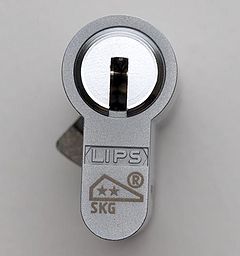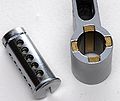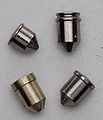LIPS Octro: Difference between revisions
m (→See also) |
m (category:skg locks) |
||
| Line 76: | Line 76: | ||
[[Category:Lock models]] | [[Category:Lock models]] | ||
[[Category:Pin-tumbler locks]] | [[Category:Pin-tumbler locks]] | ||
[[Category:SKG locks]] | |||
Latest revision as of 00:36, 26 December 2022
LIPS Octro
| LIPS Octro | |
 | |
| Name | LIPS Octro |
|---|---|
| Manufacturer | LIPS |
| Lock Type | Cylinder |
| Lock Design | Pin-tumbler, Dimple |
| Related Locks | |
| KABA Gemini KESO 2002 | |
The Octro is a dimple lock made by LIPS. It uses fifteen pin-tumblers separated into rows of five at 9, 12, and 3 o'clock in the lock. The Octro is similar in function to the KABA Gemini and KESO 2002 locks. Unlike the Gemini, the Octro is vulnerable to key bumping.
Principles of operation
The Octro is a triple-bitted dimple lock with a total of fifteen pin-tumblers. There are three rows of five pins at 9, 12, and 3 o'clock in the lock. The rows at 3 and 9 o'clock are the "side" pins, and the 12 o'clock pins are the "top" pins. The top pins interface with the bitting on the thin side of the key, while side pins interface with the bitting on the flat sides of the key (like normal dimple locks).
Each row of pins uses a loading tray to hold driver pins and springs. Each loading tray can have offset chamber bores that associate with offset bores in the plug. This allows the Octro to provide complex master keying by having physically offset pin positions on a per-lock basis. Though bore positions may differ between locks, keys can have cuts in all bore positions. This lets the key to be used in locks with different bore patterns as part of a complex master keying system.
There are a total of ten bore positions for top pins, allowing for two different bore patterns (1 3 5 7 9, 2 4 6 8 10). Side pins offer eleven bore positions, with any given lock using 5 positions on one side and 6 on the other (for example: 1 3 5 7 9, 1 3 5 7 9 11). Keys are bitted for both patterns on both sides of the key to allow the key to function in either orientation.
The top pins offer three bitting depths in a normal system, four for master keyed systems. Side pins offer four bitting depths. The high number of pins gives this lock 254,803,968 (410 * 35) theoretical key differs. Master keying for Octro locks is done by replacing bottom pins with "blind" pins that do not need to be lifted to the shear line.[1]
Notes
- Octro keys are not warded.
Disassembly instructions
Disassembling the Octro is similar a traditional pin-tumbler lock, though care must be taken because of the high number of components. Distribution of pins along three sets of chambers must be considered when removing the plug from the cylinder.
- Remove the cam or C-clip.
- Insert the key and turn the plug 45-90 degrees.
- Withdraw the plug from the cylinder. (A plug follower is recommended)
OR
- Remove the chamber casings and take out each pin-stack individually
- Remove the cam or C-clip.
- Withdraw the plug from the cylinder.
Vulnerabilities
The Octro may be vulnerable to one or more of the following:
Notes
- The Octro can be bumped because of the 90° spacing between pins. The KABA Gemini, a similar lock, does not have this problem because of the 15° tilt to the side pins.
Gallery
Plug used in the Octro.
References
- ↑ PULFORD, Graham (2007). High Security Mechanical Locks: An Encyclopedic Reference. ISBN 0750684372.








